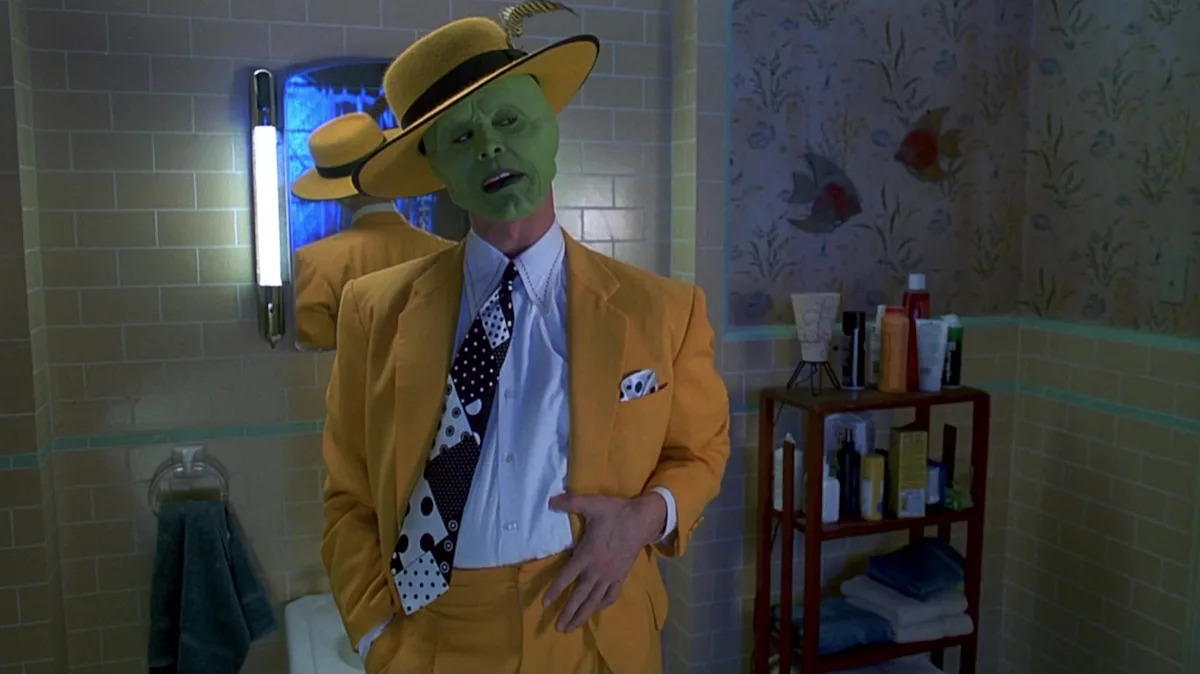
A Hit ’90s Movie Franchise Began Its Life As A Niche DC Comics Pitch
Chuck Russell’s supernatural comedy “The Mask” was one of three gigantic hits that pit Jim Carrey on the map in 1994. Carrey, of course, had been racking up acting credits since the early 1980s, but 1994 saw the release of “Ace: Ventura: Pet Detective,” “The Mask,” and “Dumb and Dumber,” which collectively made $707 million. Carrey skyrocketed to the top of the Hollywood pantheon, and was soon fetching $20 million salaries. Not bad for a quirky Canadian kid who was once so impoverished, he and his family had to live out of their car.
In “The Mask,” Carrey plays a shy, nebbishy character named Stanley who finds an enchanted mask that turns him into an uninhibited human cartoon. Carrey’s trademark cartoonish physicality was well-employed, but it was also enhanced by some state-of-the-art computer effects that turned him into a character from a Tex Avery animated short. “The Mask” was based on a series of ultra-violent, extra-bloody comic books put out by Dark Horse Comics, and while the film isn’t as violent as the source material, director Russell was careful to keep the tone closer to film noir than to slapstick comedy. Stanley will eventually run afoul of some gangsters. The film was successful enough to warrant a sequel, “Son of the Mask” in 2005, but you really, really don’t need to see that.
The original character of the Mask has a bit of a complicated history, as he was born of several artists’ efforts. Back in 2019, Forbes magazine spoke with the makers of the movie “The Mask,” as well as Mike Richardson, the originator of the Mask character. Richardson revealed that he actually based the Mask on two established DC comics characters. Specifically, he combined the Joker and an obscure villain called the Creeper.
Read more: 10 Actors Who Died On Set
The Mask was conceived as a combination of the Joker and the Creeper

Stanley Ipkiss, possessed by the Mask, holding large cartoony guns in The Mask – New Line Cinema
Richardson has told the story before, explaining that he first sketched out the character for a single-panel strip in 1985. Richardson, it should be explained, was the founder of Dark Horse Comics, a company he started in 1986. He launched the brand with two titles: “Dark Horse Presents” in July, and “Boris the Bear” in August. That was followed by “The American,” some horror comics by Basil Woolverton, and the downbeat superhero title “Concrete.” “The Mask,” as we have come to know the character, didn’t debut until 1987, in the pages of “Dark Horse Presents.” The character was credited to Richardson and artist Mark Badger.
But back in 1985, Richardson was still pitching ideas to larger companies, and felt that “The Mask” would be a fun character to sell to DC Comics. As Richardson said:
“Originally, I was gonna draw a comic and we were gonna submit it to DC, I think. I was gonna draw it [and] Randy Stradley was gonna write it. The idea I had was sort of a combination of a Steve Ditko character, The Creeper, with a Joker sense of humor to it. I would say it was semi-evolved by the time I was done with it.”
Strandley was one of the chief editors at Dark Horse Comics, a position he held for 35 years. He and Richardson collaborated a lot. Stradley may be best known for writing “Alien vs. Predator” comics as well as hundreds of “Star Wars” comics.
Both the Joker and the Creeper, incidentally, are Batman villains. The Creeper, a violent impish character, had been around since 1968, and was an ordinary man possessed by a trickster deity. One can see the Mask in there.
Mike Richardson ended up collaborating with a guy from Marvel on The Mask

Stanley Ipkiss holding up a mask in a mirror in The Mask – New Line Cinema
Because the character wasn’t yet fully formed, Richardson contacted Badger, a colleague who had been working at Marvel Comics at the time. Badger did art for Marvel in the 1980s, including “The Incredible Hulk,” “Doctor Strange,” “Gargoyle,” and “Excalibur.” He also did gigs for DC Comics, including for “Batman,” and “The Spectre.” When Badger heard Richardson’s Joker/Creeper character idea, he began to develop it further, and the idea for “The Mask” began to form. Eventually, the character made his way to the published page. As Richardson explains:
“We started Dark Horse [and] I explained the idea to a writer/artist who was working at Marvel at the time by the name of Mark Badger. We did the first series in the pages of ‘Dark Horse Presents.’ He actually changed the spelling to ‘Masque,’ which was, I guess, his way of making it his own.”
Badger, meanwhile, recalls the early collaborations, and what he and Richardson contributed to the character. His ideas, however, were a little too wild for mainstream readers; Badger envisioned The Masque as a South American deity imposing chaos in modern North American cities. That didn’t last. Eventually the character was re-worked entirely.
In 1989, writer John Arcudi, Dark Horse editor Chris Warner, and artist Doug Mahnke came up with the Stanley Ipkiss character, and the idea that the titular Mask would turn its wearer into a green-faced, large-toothed, ultra-violent, vengeance-seeker. That version of the character stuck, and was revisited by Dark Horse Comics multiple times over the years.That was the version Chuck Russell’s film was based on.
As mentioned, the movie wasn’t as dark or violent as the comics, but it’s still enjoyable. But again, you never need to see “Son of the Mask.”
If you’re looking for the easiest way to keep up with all the major movie and TV news, why not sign up to our free newsletter? You can also add us as a preferred search source on Google.
Read the original article on SlashFilm.



